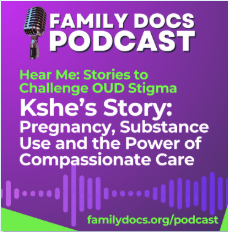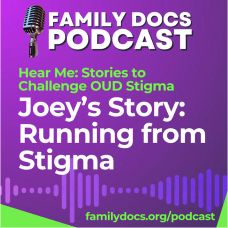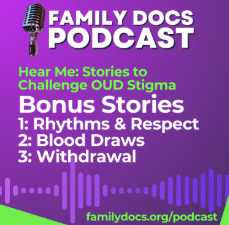Podcast Series
Hear Me: Stories to Challenge OUD Stigma This series amplifies the voices of individuals who’ve faced stigma in healthcare due to opioid use, race, identity, pregnancy, and trauma. Through raw, personal stories like Joey’s and Kshe’s, these brief but powerful episodes invite reflection, empathy, and action—because compassionate care begins when we choose to hear.
VIDEOS
ASAM Clinical Tips: Understanding Pain Management and Opioids 4 NEW videos listed below. Please scroll down for 15 additional videos.
Effective Communication Strategies for Managing Pain (Time: 7:36) Dr. Arianna Campbell, a PA at The Bridge Center, Public Health Institute, focuses on enhancing healthcare professionals’ ability to communicate effectively with patients experiencing pain. Resources
Types of Pain (Time: 7:09)
Dr. Michael Cheshire, an internal medicine physician at West Virginia University Medicine, offers an overview of different pain classifications, including nociceptive, neuropathic, and idiopathic pain. Resources
Patient Education: Explaining Pain Management Options (Time: 6:04) Dr. Michael Cheshire, an internal medicine physician at West Virginia University Medicine, provides practical strategies for explaining various pain management options to patients in clear, concise, and accessible language. Resources
Developing Patient-Centered Pain Management Treatment Plans (Time 7:17) Dr. Anita Karnik, an addiction psychiatrist at the Phoenix VA Health Care System, guides learners through the process of creating individualized, patient-centered pain management plans. Resources
Opioid Equianalgesic Dosing Example
Show example calculation of converting between opioid medications. (time 3:21)
Difference Between Physical Dependence and Addiction
Clarifies the critical distinctions between physical dependence and addiction to opioids, following the 4 Cs framework: Compulsion, Control, Continued use despite harm, and Craving. (time 1:52)
Kathleen’s Chronic Pain Journey
A patient shares the stigma she encounters, her reluctance to rely on pain medication, and the consequences when she doesn’t take it. Her story emphasizes the need to be treated with respect and compassion. (time 1:23)
Medical Marijuana for Pain Management
Addresses this common question by discussing the importance of being familiar with the laws in your state and the need for caution when discussing medical marijuana with your patient. (time 2:08)
Treating OUD with Buprenorphine
A healthcare clinician shares her experience of integrating buprenorphine treatment for opioid use disorder (OUD) into her emergency room practice and the importance of primary care clinicians being able to effectively treat individuals with OUD. (time 5:02)
Guiding Patient Expectations in Pain Management
Highlights the importance of guiding patient expectations through shared decision-making using a SHARE approach to improve pain management outcomes. (time 3:52)
Ordering a Urine Drug Test
Brief demonstration of effective, transparent communication with patients about ordering a urine drug test, which helps patients feel more comfortable and cooperative. (time 00:25)
Administering the Opioid Risk Tool-OUD
Thorough demonstration of using the ORT-OUD risk assessment tool, modeling the importance of empathy and compassion. (time 5:52)
Opioid Use Disorder DSM-5-TR Criteria
Outlines the behavioral aspects of the 11 criteria of opioid use disorder according to the DSM-5-TR. To meet the diagnosis, a patient must exhibit at least two of these criteria within a 12-month period. (time 4:03)
Motivational Interviewing Video
Enhance your communication skills and patient interactions with these proven motivational interviewing strategies. (time 1:53)
Opioid Therapy Beyond 2 Weeks
Considerations for patients requiring opioid therapy beyond two weeks. Implementing a clear tapering strategy and disposal of unused opioid to prevent misuse and ensure safety. (time 0:59)
Video Series: Addressing Stigmatizing System, Institutional, and Language Barriers
These excerpts provide tips for overcoming system and institutional barriers, as well as the importance of language used when discussing people with substance use disorders.
Acknowledgment: This education is supported by an independent educational grant from the Opioid Analgesic REMS Program Companies (RPC). Please refer here for a listing of the member companies.



